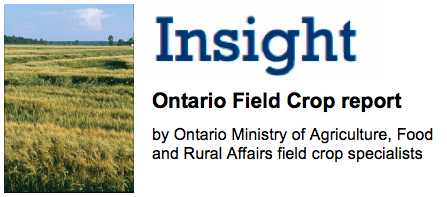Cereals: Peter Johnson
Double normal rainfall in April (150 mm) caused significant yellowing in low spots, with heavy clay soils showing “tile run” wheat. Drier conditions will allow most of this wheat to recover with limited yield impact. Nitrogen losses from early applied N in affected areas could be significant. Wheat damage reports are at extremely low levels (<1%) with the exception of winter wheat planted east of Kingston which has significant winterkill.
Winter annual weeds have bolted and control will now be difficult: fall control is far superior. Annual weeds are germinating. Advanced wheat has moved into the stem elongation stage (Zadok’s 31) with the push on to get nitrogen applied. Nitrogen applications range from 10 to 50% complete, with 30% applied provincially as of April 30th.
Spring cereal plantings are delayed, with little frost seeding accomplished. Consider shifting to 6 row barley: 6 row barley tends to tolerate late planting better. Reduce N applications on barley and oats in longer season areas on late planted cereals. Yield potential is reduced on late planted cereals due to heat stress concerns.
Forages: Joel Bagg
Scattered reports are coming in from across the province of alfalfa winterkill in some of the higher risk older stands and fall harvested stands. Extensive winterkill has occurred in eastern Ontario, from Arnprior south, east to Quebec and west to about Brockville. There are reports of 75% winterkill in some of these areas, particularly on flat, heavier clays in the Ottawa Valley. This winterkill includes some new seedings, as well as orchard grass. A cool, wet spring has delayed green-up and spring seeding, further complicating how to manage the situation. Forage inventories are exceptionally low for this time of year, and record high hay prices continue to be reported.
Alfalfa fields should be scouted for winterkill and heaving by digging plants and assessing roots and crowns for plant health and disease. Fields that showed signs of stress or disease last year, fall harvested fields, and fields that are slow to green-up should be priorities for monitoring. Using a shovel, dig alfalfa roots, rinse the soil off in a pail, and use a knife to cut open the root and crown. Watch for crown and root rots, brownish discolouration, spongy texture and lack of secondary roots and nodulation. Plant health is often more significant than plant density to a successful yield. The minimum number of healthy plants per square foot should be 12 - 20 for 1st year stand, 8 - 12 plants for 2nd year stands and 5 plants for a 3rd year or older stand. Refer to “Check Alfalfa Stands This Spring and Make A Plan” http://fieldcropnews.com/?p=5845.
Pastures: Jack Kyle
The cool temperatures have delayed pasture growth. Delay turnout until there is at least a 2nd leaf of new growth on the grass plants. Turning out too early will result in reduced growth throughout the grazing season and reduce the amount of fall grazing that will be available.
Corn: Greg Stewart
Less than 10% of the corn acreage has been planted to date; mostly on sandy soils or where rainfall amounts were lower. Switching away from full season hybrids should be not be considered until May 20-25 in areas rated at 2800-3200 CHU and May 30 in areas over 3200 CHU.
Producers anxious to increase planting productivity once weather improves may consider shifting nitrogen applications to the post-planting window. Plans for broadcast N surface applications after planting need to take into consideration the risks of losing nitrogen through volatilization. Some surface N loss reminders: 1) Risk is much higher for Urea than for UAN, 2) Protected Urea (i.e. Agrotain treated or ESN) can be a viable option for reducing N loss if timely rain (within 5-7 days) does not occur after application. 3) N loss risk for both Urea and UAN increases significantly in higher (> 20%) crop residue cover situations. 4) Flat fan spraying (i.e. weed and feed programs) or streamer nozzle applications of UAN do not appear much different in their susceptibility to volatilization loss on bare soil. 5) UAN application on higher residue situations, especially when using flat fan approaches should consider using volatilization inhibitors (i.e. Agrotain). 6) Sidedress injection of UAN, where the UAN is covered with soil, essentially eliminates volatilization losses.
Canola: Brian Hall
Planting into good soil conditions is more important than seeding date. Ideal seeding depth is 1 – 2.5 cm (1/2 – 1 in). Deeper seeded canola is more prone to emergence issues, disease and insect damage. Seeding slower can improve seed placement and result in more uniform emergence. Packing before planting can help control seeding depth if the seedbed is loose and will conserve soil moisture. Yields will be optimized from the first 17-28 kg/ ha (15-25 lbs/ac) (29-50 lbs/ac MAP fertilizer) of seed-placed phosphate (P205) even on high testing soils. Starter phosphorus will have biggest benefit on low testing soils.
Check seed size in targeting optimum seeding rate. Seed size varies considerably from year to year, and between varieties. Bulking of seed with MAP or minimap (11-52-0), pelletized sulphur or corn cob grits are options for improving seeding rate accuracy. Seeding through the grass seed box is another option, with the seed tubes inserted into the disc openers.
As insurance against sulphur deficiency apply 17-28 kg/ha (15-25 lbs/ac) of actual sulphur.
For more information please contact the CropLine at 1-888-449-0937 or visit www.omafra.gov.on.ca/croppest



